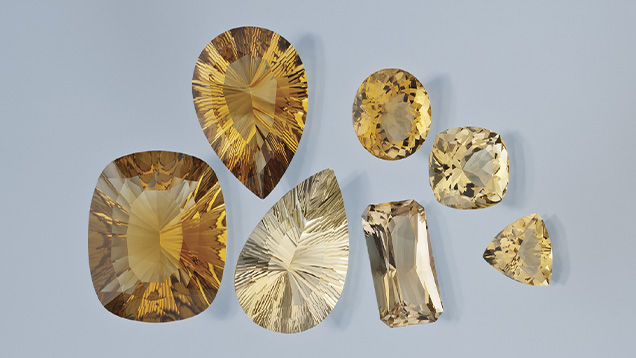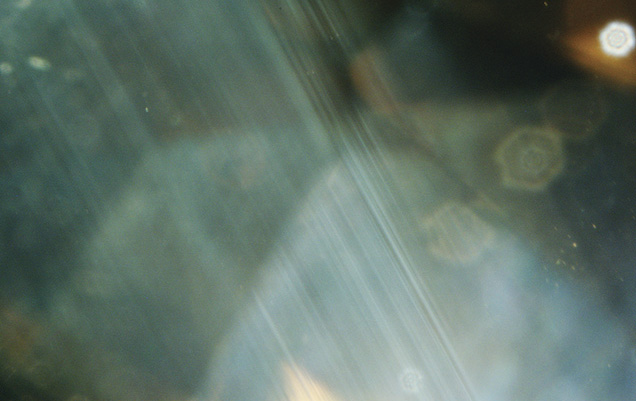Citrine from Zambia


Figure 2. Hazy clouds and bands are common features in the Zambian citrine. Photomicrograph by D. Beaton; image width 2.7 mm.
Mr. Blauwet loaned seven of the cut citrines to GIA for examination, ranging from 3.38 to 43.86 ct (figure 1). Concave facets on the three largest pieces accentuated their brilliance. The color of the citrine ranged from pale slightly brownish yellow to brownish orangy yellow, and the seven stones showed the following gemological properties: RI— no = 1.542, ne = 1.552; birefringence—0.010; hydrostatic SG—2.65–2.66; UV fluorescence—inert to both long- and short-wave UV radiation, except for one pale yellow sample that fluoresced very weak white to long-wave UV; and no features seen with the desk-model spectroscope. Microscopic examination revealed straight and angular color zones, as well as a general haziness and bands of hazy particles (figure 2), which proved natural origin and were similar to those described in citrine from Sri Lanka (E. J. Gübelin and J. I. Koivula, Photoatlas of Inclusions in Gemstones, Vol. 2, Opinio Publishers, Basel, Switzerland, 2005, p. 573). The 3.38 ct stone also contained a plane of parallel tubules and two-phase inclusions (figure 3). Viewed with cross-polarized light, minor areas of Brazil-law twinning were seen in only the two smallest samples.
Figure 3. The 3.38 ct triangular modified brilliant in figure 7 contains a plane of elongated
tubules and two-phase inclusions. Photomicrograph by D. Beaton; image width 1.5 mm.
FTIR spectroscopy revealed the absence of a 3595 cm–1 band. This feature is sometimes used as confirmation of natural quartz, especially amethyst, when it is well resolved and there are no diagnostic natural inclusions (S. Karampelas et al., “Infrared spectroscopy of natural vs. synthetic amethyst: An update,” Fall 2011 G&G, pp. 196–201). In citrine this feature is often absent, so proper identification must rely on inclusion observation, or the analysis of trace elements (C. M. Breeding, “Using LA-ICP-MS analysis for the separation of natural and synthetic amethyst and citrine,” www.gia.edu/gia-news-research-nr73109a).tubules and two-phase inclusions. Photomicrograph by D. Beaton; image width 1.5 mm.
Natural-color citrine is less common than other quartz varieties such as amethyst and smoky quartz. Assuming that the coloration of this citrine is natural—as represented by the supplier—this large, clean material makes a nice addition to the gem market.



